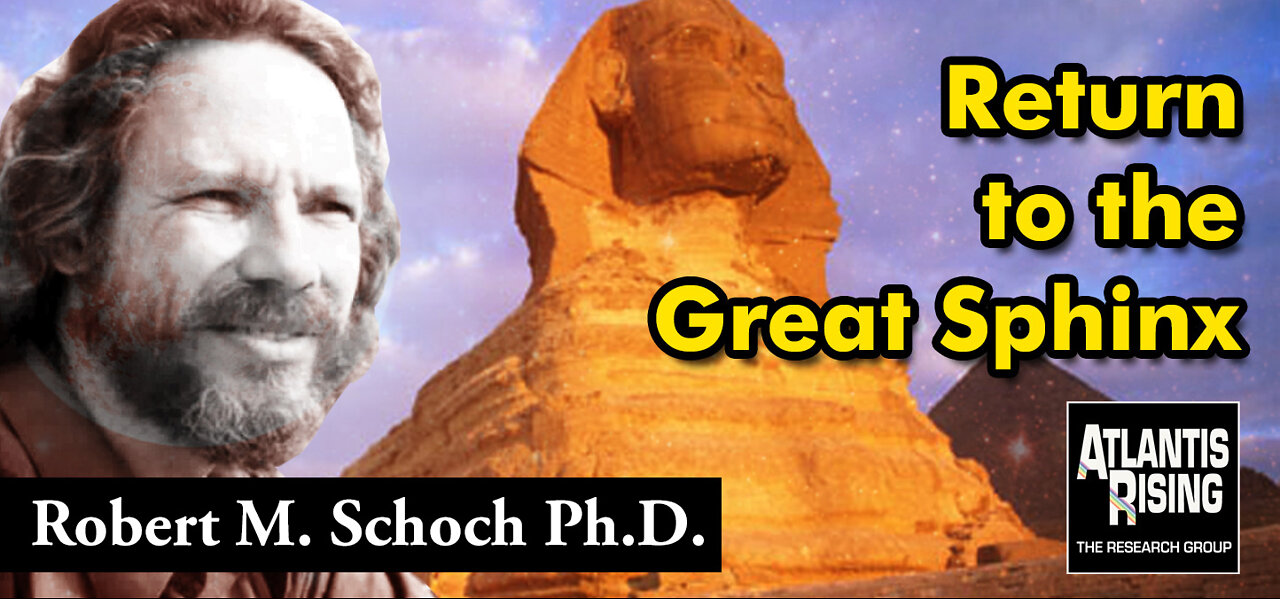Premium Only Content

Dr. Robert M. Schoch - Return to the Great Sphinx - Atlantis Rising Magazine
Visit Atlantis Rising Research Group at https://www.atlantisrising.com/
Perhaps one of my distant ancestors or relatives preceded me here—among nineteenth and early twentieth century graffiti inscribed on the entrance to Nefertari’s Temple of Hathor at Abu Simbel can be found my name—“Schoch.” I had noticed this on previous trips, but this time it really impressed me. Perhaps I was feeling nostalgic; it was just short of a quarter century since I had first traveled to Egypt (in June 1990). As I have always found to be the case, my most recent trip (January 2015) yielded fresh revelations and new connections.
My wife Katie (Catherine Ulissey) and I traveled with members and associates of The Khemit School of Ancient Mysticism, including Yousef and Patricia Awyan, Mohamed Ibrahim, and Gary Evans. One of the major points of discussion throughout the trip was that in many cases inscriptions, be they on temples, tombs, sculptures, or other objects, do not necessarily serve to date the origins of such objects. Certainly the “Schoch” inscription on the Abu Simbel temple does not mean that a Schoch had anything to do with the building of the structure! Yousef and Mohamed pointed out case after case where an older statue or monument had been appropriated by a later pharaoh or notable and inscribed with his or her name.
The concept of re-appropriation is not a new idea. I came to this conclusion during my earliest studies (1990) of the Great Sphinx of Giza and its associated temples. Egyptologist Selim Hassan (1887–1961), who re-excavated the Great Sphinx in the 1930s, also noted many cases of reuse, including a classic example, which he discusses, in his 1949 book, The Sphinx: Its History in the Light of Recent Excavations, the “Hyksos” or “Tanis” sphinxes. These are carved stone “sphinxes” (actually more accurately described as lions with human faces; they lack the full human head and headdress of more typical sphinxes), some of which are inscribed with the name of the fifteenth Dynasty “Hyksos” Pharaoh Apepi (Apopi, Apophis, Ipepi) who reigned in the sixteenth century BCE. Following the Hyksos period various Tanis sphinxes were reused over and over. An example, now housed in the Egyptian Museum (Cairo), includes cartouches of Apepi, Merneptah (nineteenth Dynasty, reigned late thirteenth century BCE), and Pasibkhanu I (Psusennes I, Pasebxanu I, twenty-first Dynasty, reigned late eleventh century BCE). However, since at least the nineteenth century, it has been suspected that the statues are actually much older than Apepi and were reused during the Hyksos period. Some authors have even suggested that they date to predynastic times, at least 1500 years earlier. The consensus now appears to be that these sphinxes date to the Middle Kingdom, most likely to the reign of the twelfth Dynasty pharaoh Amenemhat III who ruled during the nineteenth century BCE. Hassan concluded, “The presence of the name of the Hyksos King Apopi, which occurs on some of these sphinxes, is only one of the many usurpations which they have undergone, and re-cutting of the stone can be clearly seen” (p. 99). Furthermore, these supposed “Middle Kingdom sphinxes” may, in fact, be reused older statues. “It may be that some of the best specimens attributed to this period [Middle Kingdom] are in reality Old Kingdom [circa twenty seventh to twenty second centuries BCE] work, usurped and altered in detail to meet the prevailing fashion,” Hassan writes (p. 96).
It was not only these smaller sphinxes that were usurped but the Great Sphinx as well. Hassan describes how the Great Sphinx was venerated and “reused” during New Kingdom times, especially under the successive eighteenth Dynasty pharaohs Amenhotep II and Thutmose (Thutmosis) IV (their reigns spanned the late fifteenth and early fourteenth centuries BCE). The cult of the Great Sphinx persisted, being at times more or less popular, for nearly two thousand years. What about the origins and earlier history of the Great Sphinx?
Some early classical Egyptologists (nineteenth and early twentieth centuries) thought the Great Sphinx might trace its origins to well before dynastic times. One such authority was Gaston Maspero (1846–1916) who, among other positions, served for a number of years (1881–1886, 1899–1914) as the director-general of excavations and antiquities in Egypt and co-founded the Egyptian Museum in Cairo (opened in 1902). Maspero suggested that the Great Sphinx is the most ancient monument in Egypt, older than the pyramids and other dynastic structures.
-
 LIVE
LIVE
Badlands Media
9 hours agoDEFCON ZERQ Ep. 013
6,186 watching -
 LIVE
LIVE
SpartakusLIVE
4 hours agoLIVE from SUPER SECRET, VIP Location || BEACH FRONT into Verdansk
792 watching -

Flyover Conservatives
22 hours ago"The Testosterone Levels of a Baby Bird" - America’s Health Crisis w/ Dr. Troy Spurrill | FOC Show
11.8K -
 LIVE
LIVE
PandaSub2000
1 day agoLIVE 10pm ET | SONIC RACING CROSSWORLDS with YOU!
117 watching -
 LIVE
LIVE
Drew Hernandez
6 hours agoDISGRACED SCOTUS REJECTS ALEX JONES' INFOWARS FREE SPEECH APPEAL
822 watching -
 3:58:57
3:58:57
GrimmHollywood
5 hours ago🔴LIVE • GRIMM'S TUESDAY FRIGHT NIGHT with LEEMIDA • LITTLE NIGHTMARES 3 • PART 1 •
431 -
 2:20:19
2:20:19
FusedAegisTV
3 hours agoGame & Rant #69 | CNN Mad Men Like To Look At Women, Nurse Joy Blackface? WTF Pokémon
3251 -
 45:11
45:11
MattMorseTV
5 hours ago $22.22 earned🔴Dems. MELT DOWN over LEAKED MESSAGES.🔴
86.7K95 -
 LIVE
LIVE
SOLTEKGG
2 hours ago🔴LIVE - MORNING BATTLEFIELD 6 | Best BF6 settings
15 watching -
 3:07:30
3:07:30
EzekielMaxwellVT
4 hours agoVTuber/VRumbler - Final Fantasy XIV Online - Dawntrail - Descent to the Foundation
98